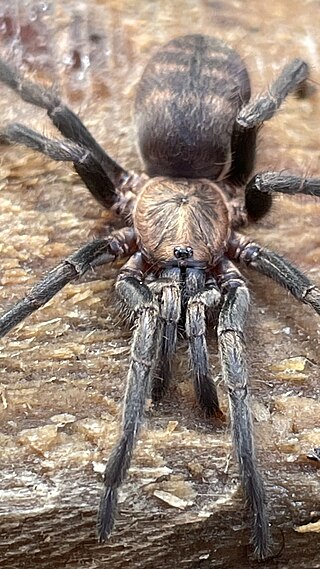
Nemesiidae is a family of mygalomorph spiders first described by Eugène Simon in 1889, and raised to family status in 1985. Before becoming its own family, it was considered part of "Dipluridae". The family is sometimes referred to as wishbone spiders due to the shape of their burrows.
Rachias timbo is a mygalomorph spider of Argentina, named after its type locality: El Timbó, Iguazú, Misiones. R. timbo differs from Brazilian Rachias species by being smaller and having lower keels on the male embolus.
Stenoterommata uruguai is a mygalomorph spider of Argentina, named after its type locality: Salto del Uruguaí. This species is distinguished from other Stenoterommata by its spermathecae consisting of a single dome bearing numerous receptacula. Its spermathecae are similar to those of S. quena, but in S. uruguai the basal dome is more rounded.
Acanthogonatus alegre is a mygalomorph spider of Chile, its name using the Spanish word for “happy”, referring to the aspect of a happy face that the female epigastrium has in posterior view. Females are recognized by the epigastrium produced in a membranous extension and the long, slender and bifurcated spermathecae.
Chilelopsis minima is a species of mygalomorph spiders found in Chile. It formerly belonged in the genus Flamencopsis. The specific name was given because it is the smallest member of the tribe Diplothelopsini.
Chilelopsis serena is a species of mygalomorph spiders of Chile, named after its type locality: La Serena, Elqui, Region IV. Males differ from those both C. calderoni and C. puertoviejo in the absence of a patch of setae on the apical tibia I, and also in the palpal tibia having dorsal spines and the bulbal duct being abruptly narrowed at the apex. Females differ from the two other species by their divided spermathecae.
Chilelopsis puertoviejo is a species of mygalomorph spiders of Chile, named after its type locality: Puerto Viejo, Copiapó, Region III. The species is most similar to C. calderoni, but differs in having the distal portion of the male bulbal duct less sinuous and the female spermathecae of uniform width, with no differentiated fundus. It differs from C. serena in the undivided female spermathecae and the male tibia I having a dense apical patch of setae.
Chilelopsis calderoni is a species of mygalomorph spiders of Chile, named after Dr Raúl Calderón. Males differ from C. puertoviejo in the more sinuous distal portion of the bulbal duct; females differ in the spermathecae with a distinct fundus and a narrowed duct. Males differ from C. serena by the presence of a dense patch of setae on the anterior tibiae, females in the undivided spermathecae.
Lycinus frayjorge is a mygalomorph spider of Chile, named after its type locality: Parque Nacional Fray Jorge, Limarí, Region IV (Coquimbo). The female spermathecae are most similar to those of L. gajardoi, which differs by the less numerous maxillary cuspules, the lighter scopula IV, and the presence of pseudopreening combs.
Lycinus quilicura is a mygalomorph spider of Chile, named after its type locality: Quilicura, Región Metropolitana. The species is distinguished from others in the genus by its distinctly long embolus.
Lycinus tofo is a mygalomorph spider of Chile, named after its type locality: El Tofo, Coquimbo Region. Males are distinguished by the palpal bulb, more abruptly tapered than in other species of the genus; females by the long, slender, spiraled spermathecal receptacula.
Lycinus domeyko is a mygalomorph spider of Chile, named after its type locality: Domeyko, Huasco, Region III. It is the smallest species in the genus. Its size, the size of the bulb, its short embolus and the cymbial setae directed toward the apex distinguish this species from all other Lycinus.
Chaco socos is a species of mygalomorph spiders of Chile, named after its type locality: Socos, Limarí, Region IV. This species differs from C. tigre by its spermathecae having a longer duct and a less globose fundus, and by constructing a beveled door for its burrow; the general colouration is grayish, while C. tigre is more brownish coloured.
Chaco tecka is a species of mygalomorph spiders of Argentina, named after its type locality: Rio Tecka, Chubut, Argentina. Females can be distinguished from those of other species of Chaco by the strong and numerous spines on metatarsus IV and by the presence of pseudopreening combs on metatarsi III and IV. From C. patagonica and C. sanjuanina, females differ also in the patterned cephalothorax and legs.
Chaco patagonica is a species of mygalomorph spiders of Argentina, named after its type locality in Patagonia, specifically Chubut Province, Argentina. The species can be distinguished from C. tecka by not having a patterned cephalothorax and legs, by possessing less maxillary cuspules and by the absence of pseudopreening combs. It also differs from C. sanjuanina by having few labial cuspules.

Acanthogonatus is a genus of South American mygalomorph spiders in the family Pycnothelidae. It was first described by Ferdinand Anton Franz Karsch in 1880. Originally placed with the brushed trapdoor spiders, it was transferred to the funnel-web trapdoor spiders in 1985, then to the Pycnothelidae in 2020.
Lycinus is a genus of spider in the family Pycnothelidae, found in parts of South America.
Stenoterommata is a genus of South American araneomorph spiders in the family Pycnothelidae. It was first described by E. L. Holmberg in 1881. Originally placed with the Ctenizidae, it was transferred to the funnel-web trapdoor spiders in 1985, then to the Pycnothelidae in 2020. It is a senior synonym of Ctenochelus.

Pycnothelidae is a family of mygalomorph spiders first described in 1917. It was downgraded to a subfamily of the funnel-web trapdoor spiders in 1985, but returned to family status in 2020.


